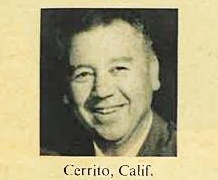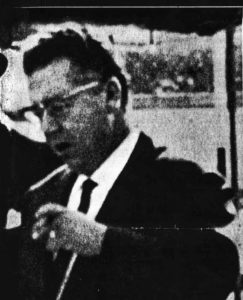The Don of Silicon Valley
Sicily native and Apalachin Summit attendee Joseph Cerrito, who died 40 years ago this month, quietly headed San Jose Mafia family

Joe Cerrito died on September 7, 1978, from a heart attack at age 67. He was a successful businessman in the San Jose, California, area, the owner of a car repair center and a large Lincoln-Mercury dealership in nearby Los Gatos. His death didn’t make any major news networks, and earned only a few paragraphs in a half-dozen papers. But for almost 20 years, Joe Cerrito was the head of a small crime family headquartered in San Jose.
While Cerrito was small potatoes compared with the larger Mafia families of the Midwest and East Coast, the Sicilian-born racketeer, who moved to San Jose in 1947, was respected enough to have attended the ill-fated Apalachin Summit meeting in upstate New York in 1957. He was also sent to Sicily to meet with fellow Mafiosi during a feud that crime boss Joe Bonnano had with New York’s ruling Commission in the mid-1960s.
Cerrito inherited control of the San Jose crime group on September 10, 1959, after the death of his predecessor, Onofrio Sciortino. He maintained a close grip over his members, to the point that he really wanted them to avoid petty street crimes in favor of working on legitimate businesses. The FBI was able to cultivate an informant in the Cerrito family in the early ’60s.

The information gained by the feds outlined the extent of the family. The gist was that it didn’t engage in much criminal activity. The informant told the FBI that after the family inducted him as a member – behind a cheese factory in San Jose – he was told he would have to pay $5 a month into the organization, though that requirement was later dropped. The family also informed him he might be called on to commit a crime, but that he could never commit a crime without the okay of the organization. However, they told him that if he were to commit a crime, he was to “try to do good work.”
In July 1964, Cerrito’s daughter was married, culminating in a massive reception at the St. Claire Hotel (now a Westin) in downtown San Jose. Most of the crime family attended, including Cerrito’s underboss, Emmanuel Figlia. Salvatore Profaci, son of famous Mafia boss Joe Profaci and later chieftain of New York’s Colombo family, was the only out-of-town guest, coming in from the Big Apple. He owned property east of San Jose in Modesto.
While Cerrito usually kept a low profile, the large wedding reception drew attention from law enforcement. It prompted Alex Camarata, a crime figure who did not attend, to be, according to the FBI, “very critical of Cerrito for inviting all these members of La Cosa Nostra to the wedding, when Cerrito himself has recommended that the members not get together at funerals, weddings and social functions.”
In November 1967, Cerrito took the unusual step of suing Life magazine for $7 million. Life had published a series of articles on the Mafia in America and featured a small photo of Joe on a map of crime bosses across the country. Cerrito was incensed and filed a lawsuit.
Accusing the magazine of libel, Cerrito’s attorney told the San Francisco Examiner that Cerrito “has never been and is not now a member of any criminal organization.” But the judge threw out the suit. To make matters worse, when Life found out Cerrito was suing them, they published an in-depth article devoted to him, laying out his crime ties.

By the late ’70s, Cerrito’s small crime family had dwindled in size and influence. After his death, he was succeeded by Angelo Marino. Other Mafiosos did not hold Marino in high regard. Tampa, Florida, boss Santo Trafficante Jr. told San Diego mobster Frank Bompensiero that Angelo was a “very weak man who could not kill anyone even if his life depended on it,” that he had “no talent whatever for LCN activity” and spent all his time “chasing women and gambling while his father had to run the California Cheese Company.”
It was at the cheese company that Marino would be swept up in a bizarre murder that took more than a decade to wind its way through various court cases. A local hood, Peter Catelli, was allegedly extorting Marino and his son Salvatore. The Marinos summoned Catelli and his father, Orlando, to the cheese company one day in 1977 for a meeting. Salvatore took the younger Catelli into a room and shot him dead. When Orlando went in to see what happened he was shot in the head, but survived. Orlando lived to testify against the Marinos. Angelo was initially convicted of conspiracy to murder, but while awaiting a new trial on the charge he died of heart failure in 1983. After four trails, Salvatore Marino was convicted of second-degree murder in 1991.
The Marino trials represented the last vestiges of the San Jose crime family. After Angelo Marino died in 1983, Cerrito’s longtime ally Figlia (who died in 2009) supposedly succeeded him. But the family was basically defunct. In the “Organized Crime in California Report,” submitted to the California Legislature in 1986, the state officials remarked that “the Southern California crime family is the only functioning traditional organized crime family based in this state.” In 2002, a new report reinforced that assessment, stating that activity in San Francisco and San Jose was dormant while the Southern California crime family stood as the only traditional organized crime group on the West Coast.
Joseph Cerrito didn’t live to see the end of his crime family, nor the massive changes to the city of San Jose he oversaw. Just three years before his death, the tech giant Apple was founded less than 10 miles from Cerrito’s auto business. By the 2010s, San Jose had the third highest GDP per capita in the world. It is located at the epicenter of that now-famous conglomeration of technology firms known as Silicon Valley.
Cerrito’s former Lincoln-Mercury dealership, at 614 N. Santa Cruz Avenue, now serves as the site of the Department of Motor Vehicles in Los Gatos. And his house, where he and his wife lived from 1955 to 1969, is listed on Zillow.com today at $5,998,000.
Scott M. Deitche is an author specializing in organized crime. He has written seven books and more than 50 articles on organized crime for local and national publications. He’s appeared on the History Channel, A&E, Discovery Channel, AHC, C-SPAN and Oxygen Network. In addition, he’s been on dozens of local and national news shows, as well as more than 40 radio programs. His latest book is Garden State Gangland: The Rise of the Mob in New Jersey.
Feedback or questions? Email blog@themobmuseum.org





